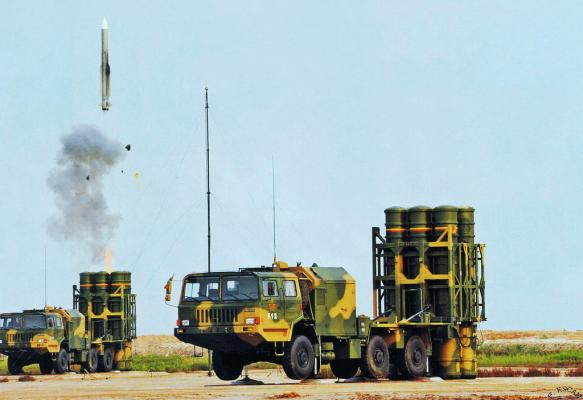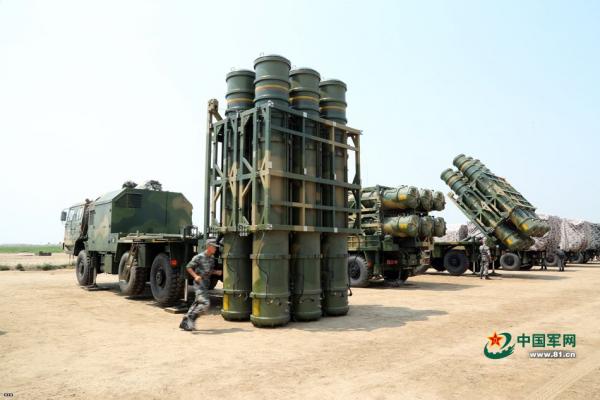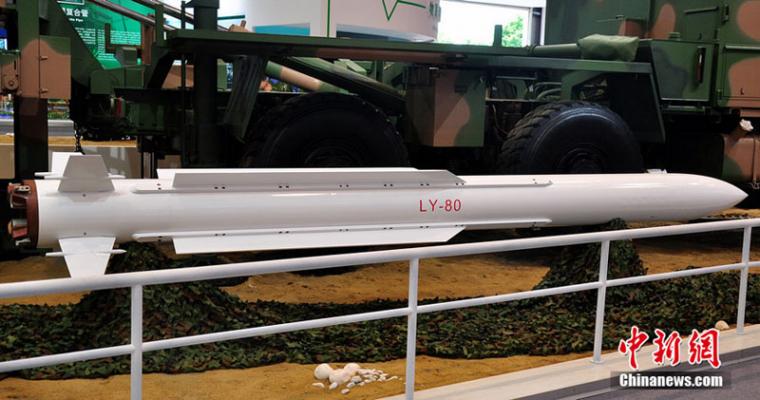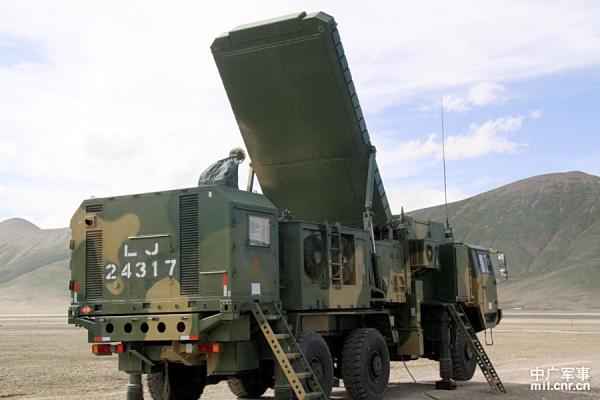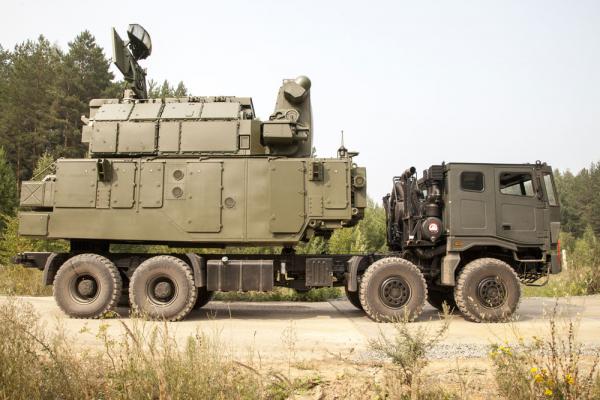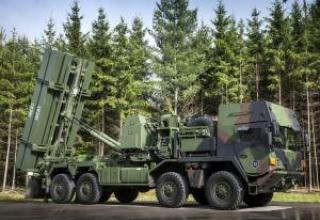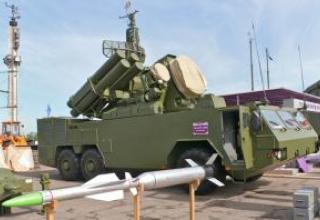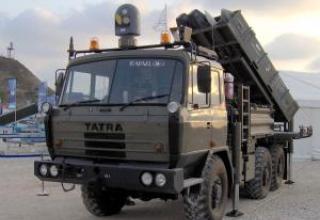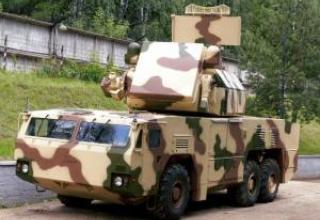The HQ-16 medium-range anti-aircraft missile system (HongQi-16, 紅旗16, "Red Banner-16") is designed to engage enemy aircraft, cruise missiles, helicopters and unmanned aerial vehicles at ranges up to 40 km day and night in all weather conditions.
The HQ-16 is designed by Chinese state company Aerospace Long-March International Trade Co Ltd (ALIT). According to a number of sources, it is the result of a joint Sino-Russian project to upgrade the Stil ship's SAM system installed on the destroyer squadrons at the Ave. 956 of the Chinese Navy.
The first model of the HQ-16 antiaircraft system was the naval version of this SAM system, the HHQ-16, which is included in the armament of Type 054A frigates (see photo) of the Chinese Navy. These frigates are equipped with a 32-cell HHQ-16 unified vertical launcher (see photo1, photo2, photo3) and a Type 382 three-axis radar.
The first version of the land-based system, designated HQ-16A, was adopted by PLA in September 2011. At present, the HQ-16A designated LY-80 is offered for export. According to media reports, tests of an upgraded version of the HQ-16B complex began in 2012. The new version has an increased range up to 75 km and increased combat efficiency. Marine version of the complex is designed for installation on frigates Type 054B.
The media reported on plans of the Pakistani Air Force to purchase three LY-80 SAM batteries complete with IBIS-150AD detection radar for evaluation tests and possible deployment of licensed production.
Composition:
The LY-80 division consists of: a division combat control station (C2), detection radar and three fire batteries. Each battery consists of illumination and pointing radars and four launchers.
IBIS150 detection radar (see photo) - three-axis, S-band with passive phased array antenna (PHAR), installed on a telescopic mast . The range of detection of air targets is 140 km, identification of targets is up to a height of 20 km. The radar is capable of detecting up to 144 targets, the number of simultaneously accompanied targets is 48. When a target is detected, the detection radar automatically identifies the target as "its own", calculates its trajectory and provides target designation data to the backlighting and battery guidance radar.
The LY-80 launcher is located on the TA5350 off-road chassis with 6x6 wheel arrangement, developed by Taian Special Vehicle Company.
TA5350 is equipped with a Deutz BF6M1015 turbocharged diesel engine with an output of 250 hp and has a permanent all-wheel drive. Maximum speed on the highway is 80 km/h, range without refueling is ~ 800km. The car is equipped with a centralized tire inflation system.
In the front of the PU directly behind the driver's cab there is a control cabin and an autonomous power supply system driven by a gas turbine or running engine. At the rear of the unit - two bags of three transport and launch containers with missiles. The PU is equipped with navigation, top linking and communication systems.
Anti-aircraft guided missile (SAM) of the complex - single-stage solid fuel is made according to the normal aerodynamic scheme with a wing of super-small elongation. Aerodynamic rudders - folding, their opening is carried out with the help of torsions.
Start ZUR - vertical with the help of PAD'a and the subsequent launch of the marching engine at a height of 15-20m above the upper section of the TPK. A special block of gas rudders is installed on the nozzle block of the marching engine (see photo1, photo2), which provides automatic inclination of the rocket towards the target after the launch and intensive maneuvering at the initial section of the trajectory.
The missile's combat unit is a shrapnel-flagged one, equipped with a contact fuse and a non-contact radio with adaptive blast time. Control system - combined, includes an inertial system and a semi-active radar homing head (SHF). During the flight on the initial and middle sections of the trajectory the inertial system with correction by radio commands is used, on the final section of the flight the target of radar homing head is captured.
According to advertising materials, the probability of hitting the target of the "fighter" type of one missile is about 85%, "cruise missile" - 60%.
The upgraded HQ-16B missile has an extended range of up to 75 km and an improved control system. Improved performance is achieved, first of all, by increasing the length of the engine and the introduction of new technology for the production of solid propellant charge.
The L-band illumination and pointing radar is equipped with a passive phased array antenna and has a range of up to 85 km. The radar provides detection of six targets, escorting four of them and pointing at the accompanied targets up to 8 SURs. The radar operates in a quasi-continuous mode of radiation with frequency adjustment and according to the developer has high noise immunity.
The equipment for signal processing and combat situation indication provides information output to liquid crystal monitors of the complex operators (see photo1, photo2). Built-in system of documentation of the combat operation of the complex is based on modern computer technology and allows for training and analysis of the actions of the calculation numbers without any real starts of the LSD. The radar is mounted on the TA5350 off-road vehicle chassis.
Technical support facilities include: transport and charging machines (see photo), maintenance machines and test equipment.
The total time to deploy the entire system is 12 minutes.
Characteristics:
| Range of fire, km: - fighter target - cruise missile target (flight speed 300m/s, altitude 50m) |
3.5-40 3.5-12 |
| The height of the flight of the targets, m: - fighter-type target - cruise missile target |
15-18000 15-15000 |
| Probability of hitting the target of one SSD: - fighter target - cruise missile target |
0.85 0.60 |
| The length of the rocket, mm | 5010 |
| Case diameter,mm | 340 |
| Starting mass ZUR, kg | 615 |
| Weight of LSD in TIC, kg | 1300 |
| Average flight speed at maximum range, m/s | 750 |
| Available overload | 25g |
| Weight BC, kg | 65 |
Testing:
In October-November 2013 at the range of the Russian Ministry of Defense Kapustin Yar were tested version of the "Tor-M2KM" SAM system on the chassis of the Indian company Tata Motors. In the course of tests all the declared tactical and technical characteristics were fully confirmed, in particular, the combat capabilities of the complex to engage air targets at the far border of the kill zone of 15 km, targets flying at a speed of 700 m / s, as well as targets flying with a heading parameter of more than 6 km at a range of 12 km.
All-weather, all-weather and driving characteristics of the complex were confirmed. In addition, in the process of testing was tested interaction in a group consisting of a combat module, transport and charging module 9T244K, radar duty mode "Casta-2E2" and a unified battery command post "Ranzhir-MK".
